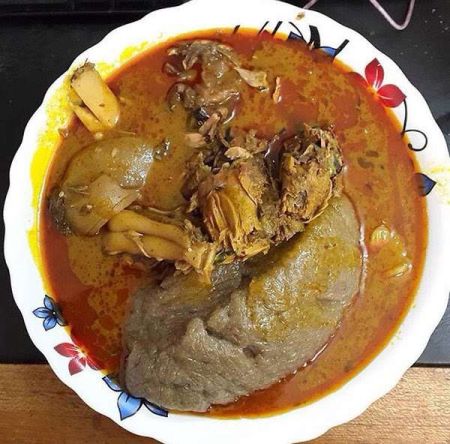Konkonte Dish from Ghana - prepared by Mary
- Written by Portal Editor
Konkonte is a Ghanaian dish usually eaten with a soup made from palm nut or groundnuts. It is popular in West African countries such as Nigeria and is also eaten in the Caribbean.
It is a simple dish made from dried and pounded Cassava or manioc root and takes upon a brown appearance once made. In Ghana the dish is locally prepared by the Akans where it's local name is derived from the Kwa languages. It is also known by many as abitie (abetee), lapiiwa.
The appearance of the fully prepared Konkonte depends on the type of cassava used and to what extent it has been dried. It generally looks brownish in colour but can also be chocolate-brown. Its colour is similar to that of the top school uniform worn by basic students in most parts of Ghana.
The basics of cooking Konkonte begins with getting the cassava from the farm or from the nearest market. Cassava is one of the most widely eaten staples across Ghana because it is relatively cheap. One can buy small amount of the flour and have enough for a whole family. It is this same cassava that is combined with plantain to prepare the local Ghanaian dish known as fufu (pronounced by some as Fufuo).
To get edible cassava, the plant must first be peeled. The peel can be used to feed livestock or used as manure to fertilize the farm yard (if you a farmer or gardener). The edible cassava is then washed. It is cut into chips. These cassava chips are usually dried in the sun, then ground at a mill into powder. There are a couple of ways to dry cassava chips. In Ghana, some farmers have a kind of tool what is termed in Twi as Apa, which simply refers to a kind of booth made of palm fronds on which farmers place their harvested maize. This booth is intentionally made over the locally made type of kitchen called Muka. This is done so that the smoke coming out of the firewood dries the maize, in this case the cassava chips. This method of drying gives the cassava chips a blackened appearance which affects the overall appearance of the final product— the prepared and cooked Konkonte.
The best method, though, is the natural way - drying the cassava chips in direct sunlight by spreading them over a drying tray usually made of a wood or aluminium big enough to spread the chips on. One noteworthy fact is that, when the undried cassava chips are left unattended for enough time, they will start developing a form of brownish-like algae on the surfaces. After developing this fungus, the appearance of the final dish will be affected. Thus it is recommended that the chips are dried while they are fresh to retain the whitish nature of the final dish. However, many believe the browning of the chips also adds to overall taste of the Konkonte. To convert the dried chips into powder, it is pounded in a mortar and pestle, or taken to the mill to be ground. This gives the final product that will be cooked by adding water, kneading it on the fire until cooked, then you have your Konkonte dish.
Konkonte powder can be mixed with room temperature water or hot water. Some people prefer adding hot water to the powder first before cooking. It is stirred on the fire until it thickens and then it is kneaded and cooked some more. If it is too thick one adds a little more hot water to it then covered with a lid for few minutes then kneaded against in the pot until the water mixes it well, (you may have to repeat the hot water addition and kneading if necessary until you get the right consistency) until it is cooked.
Some people just scoop a portion into bowl and pour their soup over it. Ready to eat.
Ingredients: Cassava (kokonte) powder Method: Boil water in an iron pot. Fetch some water aside when it begins to boil. Pour the kokonte powder in the boiling water and stir continuously to avoid lumps. Add more hot water depending on the thickness you desire. Press the kokonte against the side of the pot and cover to cook for 15 minutes. Roll into balls and serve with palm nut, groundnut or okro soup.
From Mary, a secretary at a creative art company in Accra / Ghana.
Please read as well:
